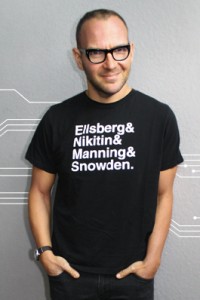Commentary: Cory Doctorow: Social Quitting

As I type these words, a mass exodus is underway from Twitter and Facebook. After decades of eye-popping growth, these social media sites are contracting at an alarming rate.
In some ways, this shouldn’t surprise us. All the social networks that preceded the current generation experienced this pattern: SixDegrees, Friendster, MySpace, and Bebo all exploded onto the scene. One day, they were sparsely populated fringe services, the next day, everyone you knew was using them and you had to sign up to stay in touch. Then, just as quickly, they imploded, turning into ghost towns, then punchlines, then forgotten ruins.
This didn’t happen to Facebook and Twitter. Both attained a scale and durability that exceeded the networks that preceded them. For many people, it seemed like the operators of these services had cracked the nut of making eternal social media. Maybe it was their access to the capital markets, which let them hire better engineering teams? Maybe it was the singular genius of their founders and leaders? Maybe it was luck?
Today, it’s getting harder to believe that these networks will last forever. In the blink of an eye, they’ve gone from unassailable eternal mountains to shifting sands that might blow away at any time. Users are scrambling to download their data and tell their friends where they can be found if (when?) the service disappears.
How did these systems go from permanent to ephemeral? How did it happen so quickly?
Here’s my theory.
When economists and sociologists theorize about social media, they emphasize ‘‘network effects.’’ A system has ‘‘network effects’’ if it gets more valuable as more people use it. You joined Facebook because you valued the company of the people who were already using it; once you joined, other people joined to hang out with you.
Network effects are powerful drivers of rapid growth. They’re a positive feedback loop, a flywheel that gets faster and faster.
But network effects cut both ways. If a system gets more valuable as it attracts more users, it also gets less valuable as it sheds users. The less valuable a system is to you, the easier it is to leave.
When you leave a system, you have to endure ‘‘switching costs’’ – everything you give up when you change products, services, or habits. Quitting smoking means enduring not just the high switching cost of nicotine withdrawal, but also contending with the painful switching costs of giving up the social camaraderie of the smoking area, the friends you’ve made there, and the friends you might make there in the future.
For social media, the biggest switching cost isn’t learning the ins and outs of a new app or generating a new password: it’s the communities, family members, friends, and customers you lose when you switch away. Leaving aside the complexity of adding friends back in on a new service, there’s the even harder business of getting all those people to leave at the same time as you and go to the same place.
Each commercial social media service has two imperatives: first, to make it as easy as possible to switch to their service, and second, to make it as hard as possible to leave. When Facebook opened up to the general public – and not just university students – it needed a plan to deal with MySpace.
At the time, MySpace was the largest social network the world had ever seen. It was overly complex, filled with spam, and often joyless, but for MySpace users, it had a major advantage over Facebook: all their friends were already on MySpace.
It didn’t matter that Facebook had a better user interface and more features. It didn’t matter that Facebook promised not to spy on its users on behalf of advertisers (yes, this was Facebook’s pitch in 2006 when it dropped the requirement that you sign up with a .edu address).
Facebook addressed this problem by giving MySpace users who switched to Facebook a bridge between the two services. Simply give this tool your MySpace login and password, and it would use a bot to login to your MySpace account, scrape all the waiting messages in your queues and inbox, and push them into your Facebook feed. You could reply to these, and the bot would log back into MySpace and post those replies as you.
Facebook attacked MySpace’s high switching costs head on, lowering them for users and unleashing network effects and rapid growth.
But as Facebook and Twitter cemented their dominance, they steadily changed their services to capture more and more of the value that their users generated for them. At first, the companies shifted value from users to advertisers: engaging in more surveillance to enable finer-grained targeting and offering more intrusive forms of advertising that would fetch high prices from advertisers.
This enshittification was made possible by high switching costs. The vast communities who’d been brought in by network effects were so valuable that users couldn’t afford to quit, because that would mean giving up on important personal, professional, commercial, and romantic ties. And just to make sure that users didn’t sneak away, Facebook aggressively litigated against upstarts that made it possible to stay in touch with your friends without using its services. Twitter consistently whittled away at its API support, neutering it in ways that made it harder and harder to leave Twitter without giving up the value it gave you.
When switching costs are high, services can be changed in ways that you dislike without losing your business. The higher the switching costs, the more a company can abuse you, because it knows that as bad as they’ve made things for you, you’d have to endure worse if you left.
I think this is what’s killing the social media giants.
Every social media service has costs (trolls, surveillance, ads, identity theft risks, etc.) and benefits (community, commerce, family). So long as the benefits outweigh the costs, you’ll probably stick around.
When benefits outweigh costs, economists call it a ‘‘surplus.’’ The surplus is the difference between the value you get from using a service and the costs exacted by your ongoing use of that service.
Companies that don’t have to worry about their users leaving – because of high switching costs and/or few competitors – can scoop up that surplus. They can spy on you more, or put more ads into your feed, or pay fewer moderators to fight harassment.
Once they have taken the surplus from you, they can allocate it to the advertisers who use their platforms – they can charge less to advertise to you, make it harder for you to skip ads, and so on. This brings in revenue, which gooses their share prices and attracts more advertisers.
But all things being equal, the company would prefer that all the surplus would end up on its own balance sheet. Once you are locked in, and once advertisers are locked in, the companies can grab the surplus away from those advertisers, too. For example, companies can create their own products that directly compete with the ones that their advertisers offer, or they can rig the ad-buying market (as Google and Facebook did when they illegally colluded on a secret project called ‘‘Jedi Blue’’).
The higher the switching costs, the more the social media companies can appropriate of that surplus – that is, the worse they can make things for both advertisers and users.
That’s what happened to MySpace and Bebo and Friendster and the other corpses in the social media graveyard: they made things worse for users and advertisers, and that meant that leaving hurt less, which meant the switching costs were lower.
As people and businesses started to switch away from the social media giants, inverse network effects set in: the people you stayed on MySpace to hang out with were gone, and without them, all the abuses MySpace was heaping on you were no longer worth it, and you left, too. Once you were gone, that was a reason for someone else to leave. The same forces that drove rapid growth drove rapid collapse.
The social media companies that are circling the drain today had a very long run. They figured out how to use the law (copyright, patent, terms of service, contract) to make it much, much harder for upstarts to offer a way to gracefully exit the system. Because they had so many of the people that mattered to us trapped inside them, and because they made it so hard to leave, they could really treat us like garbage without risking our departure. They cut the surplus to the bone.
And then…. Stuff happened. Mark Zuckerberg got worried about losing users and decided we were all going to live as legless low-polygon cartoons in a metaverse that no one wanted to use, not even the Facebook employees who built it. Twitter got bought out by a low-attention-span, overconfident billionaire who started pulling out Jenga blocks to see whether the system would fall over, and when it did, we all got crushed by the falling blocks.
These services had been shaved down to the point where most of us were only a hair’s breadth away from quitting, because all the surplus had been transferred from us and from business users to the companies.
Once things got just a little worse, advertisers and users started to quit, and the long-delayed MySpacing of Facebook and Beboizing of Twitter began.
RIP.
Cory Doctorow is the author of Walkaway, Little Brother, and Information Doesn’t Want to Be Free (among many others); he is the co-owner of Boing Boing, a special consultant to the Electronic Frontier Foundation, a visiting professor of Computer Science at the Open University and an MIT Media Lab Research Affiliate.
All opinions expressed by commentators are solely their own and do not reflect the opinions of Locus.
This article and more like it in the January 2023 issue of Locus.
 While you are here, please take a moment to support Locus with a one-time or recurring donation. We rely on reader donations to keep the magazine and site going, and would like to keep the site paywall free, but WE NEED YOUR FINANCIAL SUPPORT to continue quality coverage of the science fiction and fantasy field.
While you are here, please take a moment to support Locus with a one-time or recurring donation. We rely on reader donations to keep the magazine and site going, and would like to keep the site paywall free, but WE NEED YOUR FINANCIAL SUPPORT to continue quality coverage of the science fiction and fantasy field.
©Locus Magazine. Copyrighted material may not be republished without permission of LSFF.








The burning question is though, as users flee and businesses realise they don’t want to advertise on these platforms any more – where is everyone going, and where can we spend our digital dollars more effectively? Tiktok seems to be one answer, but sketchy is the word for that platform and many businesses don’t want to touch it. Pinterest is another option we are exploring for clients – yet to see how that will pan out, and failing that, we are left with Google and YouTube. Anyone else found anything that works?
Mastodon does what Twitter does and has no incentive to get awful.
I would not personally recommend Pinterest if you’re an artist of any type. It’s also been flooded with AI art related spam, which had I previously thought was an oddity about Twitter.
What gets me is there is some legacy animation schools I’d like to apprentice at, but I’m not sure if that’s going to be worth it if they insist on using twitter and facebook. You’d think they would learn with the strikes happening in animation circles.
Wellll, when it comes to Twitter refugees, the word I keep hearing is Mastodon. As for Facebook, I wouldn’t be surprised if a lot of them are headed for “You know, social media was always this enervating timesink anyway, maybe I’ll take this chance to get off the drug”.
Good post. I’ve seen at least one other person expressing pretty much the same idea, although this fleshes it out a bit better.
What data did you use to support your “mass exodus” opinion?
Hard to leave, surplus goes to rulers, spying on everybody? GDR 2.0.
I wanted to express my sincere appreciation for your insightful commentary on the dynamics of social media platforms and user engagement. Your analysis of the rise and fall of major networks like Twitter and Facebook provides valuable insights into the complex interplay of network effects, switching costs, and user behavior. Your ability to distill these intricate concepts into a comprehensible narrative is truly commendable. In light of your expertise, I’m curious to know how you envision the future landscape of social media evolving in response to these challenges, and whether there are any strategies that emerging platforms might adopt to avoid the pitfalls that befell their predecessors. Thank you once again for your thought-provoking work.
Mastodon!! The Fediverse is the Future!!